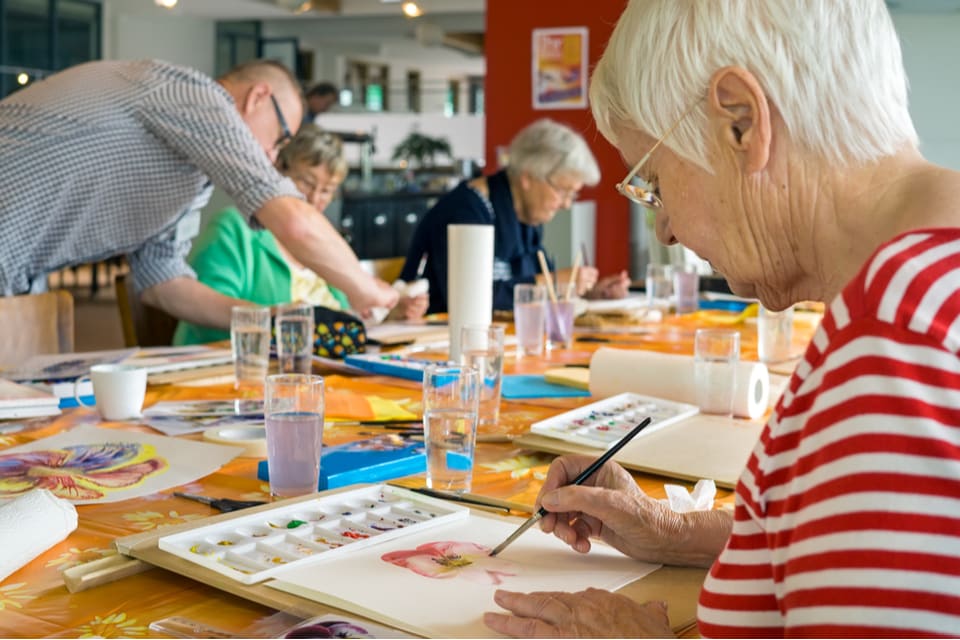
Art Therapy in Senior Living

It feels like art is almost a part of the human DNA. Art is an important part of every culture, across the entire history of humanity. There is nothing quite like feeling clay in your hands, passing a paintbrush over canvas, and bringing an image to life on paper. This essential human connection to art can even support health and well-being through art therapy — a distinct form of psychotherapy. Tailored to older adults and their specific therapeutic needs, art therapy in senior living communities empowers seniors with expression.
Let our care assessment guide you
Our free tool provides options, advice, and next steps based on your unique situation.
In this article:
What is art therapy for seniors?
“Art therapy with seniors focuses on creative self-expression, memory recall, creating a sense of calm, socialization, and empowering seniors to make independent choices,” said Julie Roush, a registered art therapist at Artfully Yours LLC Traveling Art Therapy. “Art therapy helps seniors to build trusting relationships and talk about hard truths, loss, fear, grief, uncertainty, in a gentle and kind way.”
The body-mind practice of art therapy can be tailored to meet the unique physical and mental needs of the older adults living in senior living communities. For example, through art therapy sessions or art classes, seniors can work on things like improving memory after a dementia diagnosis by drawing images from memory or exercising their hands to help arthritis symptoms by painting in expressionistic styles. The ways art can be tailored to personal needs are endless.
It’s important to note that previous art experience is not required to benefit from art therapy, as explained by Julia Andersen, licensed art therapist and graduate program director of the Art Therapy Department at Notre Dame of Maryland University.
What are the benefits of art therapy in senior living?
Recent studies suggest that art therapy and engaging in the arts offer myriad physical, emotional, and social benefits to people of all ages. According to the research review conducted by the World Health Organization on the evidence of the role of the arts in improving health and well-being, studies showed that participating in art activities can have the following benefits.
Physical
- Regulates heart rate
- Reduces physical symptoms of disease and illness
- Lowers self-reported pain scores
- Alleviates breathing difficulties
Emotional
- Improves depression
- Reduces anxiety, especially for those who have experienced trauma
- Reduces anger and agitation
- Improves body image
- Increases comfort and meaning to those at the end of their lives
- Develops new forms of self-awareness
Social
- Supports healthy social interactions
- Facilitates nonverbal communication
- Improves the strength and courage of those preparing to say goodbye at the end of life
- Increases feeling of purpose of life
- Improves relationships and communication with loved ones
Neuroplasticity
Though the positive emotional and social aspects of art are clear, the building evidence of its neurological benefits surprises scientists every day.
“Creating art influences brain wave patterns and the substances released by the brain,” according to the University of Rochester Medical Center (URMC) Health Encyclopedia.
Art therapy taps into the neural links between the brain and body, strengthening mind-body connection.
“The latest neuroscience research supports the use of art-making to restore physical and mental functioning through the concept of neuroplasticity,” said Andersen. “Art materials, such as drawing, painting, or sculpture, have inherent properties, whether tactile, sensory, fluid, or resistive, that connect or initiate pathways in the brain previously damaged due to illness and injury or inaccessibility.”

Let our care assessment guide you
Our free tool provides options, advice, and next steps based on your unique situation.
This research in neuroplasticity is even more important when thinking about seniors with memory-related illness. Research shows how art therapy can give people with dementia access to memories that were seemingly lost before. Art therapy can give someone with dementia a way to communicate again by reigniting pathways to memories through a new medium: art.
“Someone who has experienced a stroke or other brain injury may participate in art therapy with the goal of reconnecting neural pathways,” said Andersen. “Physically holding a paintbrush in the hands, mixing paint, and touching the canvas … activates symbolic, emotional, and cognitive experiences. The individual can build on these experiences to promote communication skills and emotional expression.”
Art therapy improves quality of life
Art therapists can help caregivers better understand the needs of residents to improve their quality of life in a senior living environment.
“Art therapy can allow the physical or mental changes in seniors to be seen through their art, their ability to use materials, or changes in material usage,” said Roush. “These changes in material use can be an indicator of things, like [medication] changes, life or living arrangement changes, or physical illnesses occurring in the seniors’ lives. If changes are seen, they are shared with the medical care teams for further assessment.”
As a senior’s art becomes an extension of their being that the caregiver learns to read through the art therapy sessions, the caregiver can more easily understand the senior, their moods, their personality, and what ultimately affects their well-being.
“The process of art-making is nonverbal and powerful. Many individuals are not able to verbally express themselves, or may not be aware of inner thoughts and feelings,” said Andersen. “Art-making done in the presence of the art therapist, and within the therapeutic relationship, can assist individuals in identifying feelings and conflicts in a more direct or efficient way than verbal communication.”
This nonverbal communication through art can help seniors who are unable to verbally communicate to their caregivers, like seniors suffering from effects of a stroke or dementia.
What are art therapy projects for seniors like?
These projects are led by an art therapist, who creates personalized art activities for senior residents. Art therapists are experts who have typically received specialized education and supervised training prior to working in art therapy for seniors. A qualified art therapist will typically hold a master’s degree in art therapy. They may even be a Registered Art Therapist (ATR) or working toward ATR status through the Art Therapy Credentialing Board, Roush explained.
As noted by the URMC Health Encyclopedia, an art therapist may do the following as part of an art therapy program:
- Work with people individually or in groups
- Provide supplies needed to make visual artwork
- Talk through the meanings and symbols behind the art
Art therapy in senior living can be tailored to the specific medical or personal needs of individual residents. Art therapists can work with seniors with a strong sense of independence and a full range of mobility, or seniors with Alzheimer’s or another type of dementia and limited range of motion. Most anyone can participate in art therapy.
“Art therapy can be for everyone at all skill levels. It is really about the process of creating art and not so much about the art product created,” said Roush. “Sometimes amazing art is created and that is great. But sometimes the greatest art does not look like anything; it is the mere fact that the individual participated and engaged in the process.”
Roush advised that all materials used in art therapy should be nontoxic. The following tools and mediums are typically used by art therapists for seniors to create art:
- Watercolors
- Pastels
- Drawing materials
- Collage
Art therapy also opens the door for those with visual impairments to express themselves through three-dimensional art. Art therapists can alter activities to provide a physical touch component in place of two-dimensional elements. For example, a person with a visual impairment may be able to express themselves by molding clay into an artistic form.

Talk with a Senior Living Advisor
Our advisors help 300,000 families each year find the right senior care for their loved ones.
Some materials, such as clay, may not be suitable for seniors with advanced stages of dementia, Roush explained.
Art therapy in senior living communities
While all care types — including independent living, assisted living, and memory care — may offer on-site art classes and art studios, art therapy for seniors is separate from art activities as it is led by a specially qualified therapist. Many senior living communities offer these art therapy sessions to their residents. As with many services and amenities, art therapy programs may affect the cost of independent living, assisted living, and memory care.
When on-site options aren’t available, art therapy activities for elderly adults may also be found through off-site providers in the local area. And many senior living communities may offer transportation options that support art therapy as an activity.
Though seniors in assisted living or memory care communities typically need more support — like mobility assistance — than those in independent living, they can still participate in an art therapy program.
How can I find art therapy in senior living?
Because art therapy offers so many benefits to seniors, you may be wondering how to find a senior living community with an art therapy program. If you’d like help in your search, reach out to a Senior Living Advisor at A Place for Mom. This free service offers tailored advice to help you find a senior living community with an art therapy program in your area.
Sources:
Andersen, J. (2022, April 12). Personal communication. [Email].
Aspen Institute’s Health, Medicine and Society Program. (2021). NeuroArts blueprint: Advancing the science of arts, health, and wellbeing. Johns Hopkins International Arts and Mind Lab Center for Applied Neuroaesthetics.
Emblad, S. Y. M. & Mukaetova-Ladinska, E. B. (2021, May 3). Creative art therapy as non-pharmacological intervention for dementia: A systematic review. The Journal of Alzheimer’s Disease.
Facourt, D. & Finn, S. (2019). Health evidence network synthesis report 67: What is the evidence on the role of the arts in improving health and well-being? A scoping review. World Health Organization: Regional Office for Europe.
Roush, J. (2022, April 12). Personal communication [Email].
University of Rochester Medical Center: Health Encyclopedia. (2022). Art therapy, dance therapy, music therapy, and imagery.
The information contained in this article is for informational purposes only and is not intended to constitute medical, legal, or financial advice or to create a professional relationship between A Place for Mom and the reader. Always seek the advice of your health care provider, attorney, or financial advisor with respect to any particular matter, and do not act or refrain from acting on the basis of anything you have read on this site. Links to third-party websites are only for the convenience of the reader; A Place for Mom does not endorse the contents of the third-party sites.
The information contained on this page is for informational purposes only and is not intended to constitute medical, legal or financial advice or create a professional relationship between A Place for Mom and the reader. Always seek the advice of your health care provider, attorney or financial advisor with respect to any particular matter, and do not act or refrain from acting on the basis of anything you have read on this site. Links to third-party websites are only for the convenience of the reader; A Place for Mom does not endorse the contents of the third-party sites.
Make the best senior care decision
Make the best senior care decision